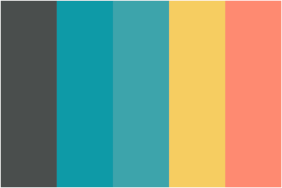Rectangular grids - choosing colors from a palette
This activity has the following desired goals:
- Learning to color a rectangular grid using colors from a palette (A, M).
- Making interesting grid based designs (M, T).
Step 1
Type in the following code and run it:
size(600, 600)
cleari()
originBottomLeft()
setBackground(cm.hex(0xF2F5F1))
val tileCount = 30
val tileSize = cwidth / tileCount
val palette = List(0x4a4e4d, 0x0e9aa7, 0x3da4ab, 0xf6cd61, 0xfe8a71).map(cm.hex(_))
def cellColor = randomFrom(palette).fadeOut(0.2)
def shape = Picture.rectangle(tileSize, tileSize)
def block(posX: Double, posY: Double) {
val pic = shape
pic.setPosition(posX, posY)
pic.setPenColor(cm.tomato)
pic.rotate(random(-5, 5))
pic.scale(randomDouble(0.95, 1.1))
pic.setFillColor(cellColor)
pic.setPenThickness(0)
draw(pic)
}
repeatFor(rangeTill(0, cheight, tileSize)) { posY =>
repeatFor(rangeTill(0, cwidth, tileSize)) { posX =>
block(posX, posY)
}
}
Q1a. Read through the code above and try to understand what it does. What does the above code do? How does it do it?
Explanation
As you can see above, a palette is defined as a list of colors, and we randomly select from this sequence to choose a color for any given cell in the grid.
There are many web based sources out there to help you come up with good palettes. Here are a few:
The idea with using the above sources is to select a palette, note down the hex codes of the colors in the palettes, and then put them in the palette list in your code (replace the # in the web code of the color with 0x in the hex-value of the color in your code).
Step 2
size(600, 600)
cleari()
originBottomLeft()
setBackground(cm.hex(0xF2F5F1))
val tileCount = 30
val tileSize = cwidth / tileCount
val palette = List(0x4a4e4d, 0x0e9aa7, 0x3da4ab, 0xf6cd61, 0xfe8a71).map(cm.hex(_))
val weights = List(1, 10, 1, 10, 3)
def cellColor = randomFrom(palette, weights)
def shape = Picture.rectangle(tileSize, tileSize)
def block(posX: Double, posY: Double) {
val pic = shape
pic.setPosition(posX, posY)
pic.setPenColor(cm.tomato)
pic.rotate(random(-5, 5))
pic.scale(randomDouble(0.95, 1.1))
pic.setFillColor(cellColor)
pic.setPenThickness(0)
draw(pic)
}
repeatFor(rangeTill(0, cheight, tileSize)) { posY =>
repeatFor(rangeTill(0, cwidth, tileSize)) { posX =>
block(posX, posY)
}
}
Q2a. Read through the code above and try to understand what it does. What does the above code do? How does it do it?
Q2b. What does the above code do different - compared to the code in step 1.
Explanation
In step 2, we give different weights to the different colors in a palette. Let’s look at the palette used above:

Let’s say you want more of the first, fourth, and fifth colors in the palette, and very little of the second and third colors. You can do this by using a weight sequence of List(10.0, 1, 1, 10, 10). This gives ten times more weightage to the first, fourth, and fifth colors:
Exercise
Write a program to make a design using the above ideas.
Copyright © 2010–2025 Kogics Foundation. Licensed as per Terms of Use.